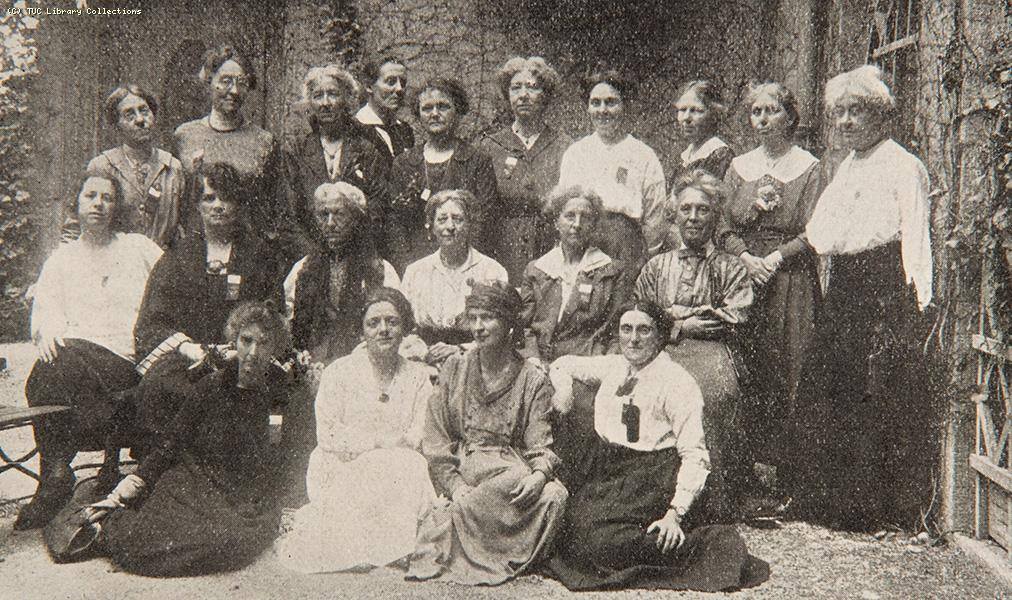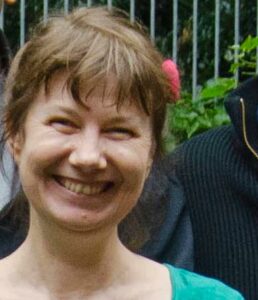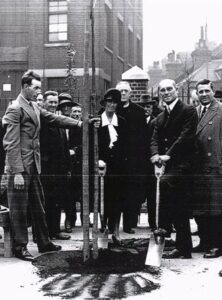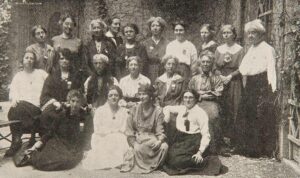
JULIA LEE BARCLAY-MORTON – YOGA, WATER AND REWRITING AUTISM
I interviewed writer Julia Lee Barclay-Morton about her experience of autism. Julia began as an experimental dramatist in New York, moving to the UK to


I talked to film maker Nicolette Burford about her documentary tracing the remarkable life of Ada Salter – environmentalist, peace activist, and first woman councillor in London. Nicolette’s film Remembering Ada, connects Ada’s legacy to the recent upsurge in non-violent resistance to climate change and ecological breakdown.
Leslie: How did your Remembering Ada documentary begin, grow and develop?
Nicolette: I first heard of Ada a couple of years ago when I went on a guided tour about her life in Bermondsey. I was awestruck by the number of trees she had planted in Bermondsey, over 9,000 before World War Two. I was amazed. How come I had never heard of her? Later I came to realise that hardly anyone outside Bermondsey had heard of her.
So I started to research her. She also had some 40,000 flowers and shrubs planted in Bermondsey. She grew up on a farm in Raunds, Northamptonshire. Her parents were Wesleyan Methodists. They were active in the Liberal Party. They introduced Ada to politics and nurtured in her a deep faith in God. She went on to be a teacher in Raunds until 1896 when, at the age of 29, she moved to London to do social work with the poor. Within months of arriving, she joined the Bermondsey Methodist Settlement where she ran a club for girls. Bermondsey at the time was home to some of the very worst slums in the country. She married a fellow Settlement worker, a doctor, Dr Alfred Salter.
In 1906, she was one of the founders of the Women’s Labour League. The league later became the Women’s Section of the Labour Party. She won the hearts and minds of the local community and in 1909 they elected onto the Bermondsey Council, making her the first female councillor in London. Her political career went on to span another 30 years. In 1911, Ada raised food donations and organised their distribution to the families of the 14,000 Bermondsey women factory workers who walked out of the factories to demand better working conditions and pay.

Ada was active in the peace movement throughout her life. In 1915, dissatisfied with the Methodist Church’s support for the war, she became a Quaker. That year, she was one of the 12 women who founded the British Branch of the Women’s International League for Peace and Freedom (WILPF) in which she remained active until a few years before she died in 1942. The WILPF now has branches in 32 countries and consultative status with the United Nations. When conscription was made mandatory in 1916, she headed the clandestine No Conscription Fellowship’s Maintenance Department, together with Violet Tillard, assisting the families of conscientious objectors who were imprisoned for refusing to fight in the war. When the war ended she and her husband nursed over 30 conscientious objectors released from prison back to health at their farm house in Kent.
A substantial number of Victorian and Edwardian middleclass women devoted themselves to charitable work with the poor. Ada wasn’t opposed to charity, but recognised its failure to uproot the causes of poverty. She was one of a small number of women who dedicated themselves to the economic and social empowerment of the poor and working classes, especially women through political processes. From the start, her overriding ambition was to tear down the slums of Bermondsey and transform the borough into a garden village in which to rehouse its slum residents.
Her ambitious plans for social housing and beautifying Bermondsey’s slums with trees and flowers were simply unheard of at the time. They came up against fierce resistance from establishment figures who, believing the poor were deserving of their miserable lot, felt they were a complete waste of money. The amazing thing was that she successfully challenged their objections. She succeeded in commissioning architecturally attractive spacious, modern houses with gardens to replace one of Bermondsey’s vilest slums, and upon their completion in 1928, moving people from the slums into them. The houses escaped bomb damage during World War Two and are now Grade 2 listed buildings.
So why do so few people know of this extraordinary woman and her remarkable achievements? As a woman and a Labour Party politician she would always have faced opponents fighting hard to cast her in the shade. She was fortunate that the man she married, Dr Alfred Salter, who was MP for West Bermondsey for 20 years, unreservedly supported her. There were other men who got on well with Ada, like the trade unionist Joe Craigie and Labour Party politician Herbert Morrison with whom she worked on the Greenbelt proposal for London. However, Alfred’s close friend, fellow MP and pacifist Fenner Brockway, in his biography of Alfred written some years after Alfred’s death, gives Alfred credit for most of Ada’s achievements and portrays Ada as a good housewife who keeps his whims in check, wiping her out of the political landscape. Memories of Ada further evaporated at the end of WW2 when the onus fell on clearing Bermondsey’s bomb sites and rebuilding the borough. Then, in 2015, following the publication of Graham Taylor’s biography of her, a statue of her was erected on the Thames embankment in Bermondsey alongside statues of her husband Dr Salter, their only child, Joyce who died from scarlet fever when she was eight, and their cat.
Ada Salter provides a strong role model; she is a woman of courage with an unerring faith in our potential to change society for the better. The film delivers messages of peace, the value of nature, inter-racial harmony and solidarity. Growing up on a farm she developed a profound love for the soil’s ability to make things grow and sustain life. Gardening was her biggest, lifelong passion. She wanted to share this love with others to brighten up their lives. Ada’s enchantment with nature and gardening is a refreshing and inspirational theme that is carried across the film.
Leslie: How did you characterise Ada and the other people in the film? What were the interpretative choices involved?

Nicolette: Having researched Ada’s life for the past two years, I have formed a connection with her. I have learnt about the things she did, things she said, and what others said about her. People said she was kind, modest, gentle yet confident and self-assured. She drew a sense of security from her religious faith. Her aims were simple, honest and pragmatic. I looked for insights into her emotional life. Two of her sisters died and one of her brothers was lost at sea. Then, in 1910, her only child, Joyce died at age 8. The sadness brought upon her by her daughter’s death never left her. It clearly underpinned her resolve to improve the living conditions of poor women who frequently lost their children. I also looked into the historical background to her work.
I shared my research findings with the actress who plays Ada in the film, and we pooled our impressions as to what Ada was like. I now envisage Ada as a finely merged composite of my own idea of what she was like and how the actress interprets her persona and character.
Ada’s story can’t be told properly without including selected information about some of the people she formed relationships and friendships with. She was close friends with the suffragette and pacifist Charlotte Despard, with Grace Kummins the child educationalist and the educationalist Eveline Lowe. She was an admirer of the pacifist Emily Hobhouse, and worked closely at different times with the trade unionists Mary MacArthur and Jessie Stephen. Of course, her husband, Dr Alfred Salter, was her most intimate source of enduring support. She and Alfred had a very special relationship, they discussed all their projects and undertakings with each other and often worked together as a team.
Providing the context is very important. Some people thought that including the black conscientious objector Isaac Hall in the film is unnecessary. They felt his story is comparatively trivial; he was just a Jamaican who spent some time at the Salter’s house, he was just one of many conscientious objectors the Salters helped. Why focus on him just because he was black? For me, his inclusion is vital. Isaac Hall had been psychologically and physically tortured during his 26 months in prison for refusing to fight in the 1st World War. On the verge of death, he left prison in 1919 and the Salters took him in. During the summer of that year a succession of anti-black riots erupted in London’s East End docks with white working- class men venting their resentment on black workers who they accused of taking their jobs. This timing and the fact that Isaac, as a conscientious objector, would have been widely regarded as a traitor, puts the Salter’s aversion to racism into perspective. By accommodating him, they risked losing a chunk of their working-class political support base. They helped him recover in their home over a nine-month period after which he returned to Jamaica.
The story of them caring for him, is not one of a white couple looking after a poor, helpless black victim, although Isaac Hall certainly was a victim of imperialism and the war. Seen on another level, he was a hero, a powerhouse of strength and endurance. He withstood every pressure put upon him to cave into the demands authorities made of him. Ada and Alfred came to the aid of a fellow pacifist, someone who shared their opposition to the Empire. Towards the end of his imprisonment, a prison guard said that Isaac Hall was the most courageous man he had ever met.
Leslie: What have you learned from working the environmental field?
Nicolette: I spent 20 years of my life studying and working in agroforestry and social forestry mainly in Brazil, Kenya, Indonesia and Cameroon until 2004. If there is one thing that I have learnt above all else, it is that our capitalistic system has done a fine job of destroying forests and indigenous lands across the world and despite the international outcry, this trend is accelerating. Back in the mid-1980s, forest encroachment rates were already causing alarm, there was already a foreboding feeling of imminent catastrophe in the air. You spend years working alongside others to protect the forest, becoming increasingly aware that you are fighting a losing battle as you watch it disappear in front of your eyes. You see the devastation that’s left behind, you are aware of all the wildlife that got wiped out with the deforestation, of the indigenous people left landless, striped of their autonomy and driven to live in shanty towns or left to work as contract farmers on palm oil plantations where their lives are reduced to plantation workers on meagre incomes, with no alternative lifestyle options available to them.

In the Amazon, vast expanses of pasture and soya plantations that extend as far as the eye can see have replaced the forest. The devastation has been crushing for traditional forest inhabitants and indigenous people. They get subjected to death threats and their energies get drained into endless legal battles that have been going on for generations. The destruction of forests is one of the biggest tragedies to hit our planet, alongside the massive plastic pollution and global warming. Most of the deforestation has taken place in the last 45 years. I think most people can’t fathom the scale of the destruction or how it has devastated wildlife populations.
My message to everyone out there is don’t buy products whose ingredients include palm oil, avoid all products made from tropical timbers, and boycott meat and soya products that originate from Brazil.
We have to move forwards in the footsteps of people like Ada. The issues of poverty, peace and environmental pollution she addressed in her lifetime are the same ones we need to address now. Hence, her life’s work is of contemporary relevance. She went out canvassing in her community, travelled up and down the country giving speeches and talked with people to help them grasp the need for trade unions, the need for quality social housing and the need for environment conservation and greening. Most importantly, she encouraged people to vote for policies that promoted the common good. She won their support and she didn’t let them down. The priorities she had then, should be our priorities now.
Leslie: What part did ethnic diversity play in your creative development?
Nicolette: I am in myself, an ethnically diverse person. My family is of European descent. Until I was twenty five, I was a contemporary dancer and I loved doing African dance. My interest in African dance morphed into an interest in rural development which I went on to pursue for the next twenty years. My relationships with people of many different cultures across the world profoundly influenced who I am, how I experience beauty and process emotions. Inevitably, my background influences the issues I would like to explore creatively. Some are issues I too want to understand more fully, others are ones that exert an aesthetic or emotional pull on me. Those that are more deeply embedded in my personal experience, form part of my tool set. They are like a dance vocabulary or the paint brushes I use to create with.
Ethnic diversity is to some extent about boundaries that need to be respected but they can be permeable and if the respect is right then there is greater freedom for communication and mutual participation in the promotion of freedom and equality across the broad. Art, dance and filmmaking are ways of communicating that have the potential to signal and awaken common or complementary interests. I have always been drawn to creative collaboration, dancing together with other people or engaging with others in other creative processes.
Ada’s community work reassures us that it is possible for us to take back the power. Ultimately, it comes down to people embracing a sense of wonder for the irreplaceable splendour of nature and the sense of wholeness that resides in solidarity and to then stand up for these things. Extinction Rebellion have, and continue to play a fantastic role in drawing the public’s attention to the scale of the problem and encouraging them to be part of the restorative process.
Next week Chris Gribble, Chief Executive of the National Centre for Writing in Norwich, talks about his work promoting the arts.
ABOUT LESLIE TATE’S BOOKS:

I interviewed writer Julia Lee Barclay-Morton about her experience of autism. Julia began as an experimental dramatist in New York, moving to the UK to

I interviewed Gillean McDougall from Glasgow, who edited the collaborative projects Honest Error (on Charles Rennie Mackintosh and his wife Margaret Macdonald) and Writing the

I interviewed French writer Delphine de Vigan, whose book, No et moi, won the prestigious Prix des libraires. Other books of hers have won a clutch

I interviewed Joanne Limburg whose poetry collection Feminismo was shortlisted for the Forward Prize for Best First Collection; another collection, Paraphernalia, was a Poetry Book Society Recommendation. Joanne

I interviewed Katherine Magnoli about The Adventures of KatGirl, her book about a wheelchair heroine, and Katherine’s journey from low self-esteem into authorial/radio success and
| Cookie | Duration | Description |
|---|---|---|
| cookielawinfo-checkbox-analytics | 11 months | This cookie is set by GDPR Cookie Consent plugin. The cookie is used to store the user consent for the cookies in the category "Analytics". |
| cookielawinfo-checkbox-functional | 11 months | The cookie is set by GDPR cookie consent to record the user consent for the cookies in the category "Functional". |
| cookielawinfo-checkbox-necessary | 11 months | This cookie is set by GDPR Cookie Consent plugin. The cookies is used to store the user consent for the cookies in the category "Necessary". |
| cookielawinfo-checkbox-others | 11 months | This cookie is set by GDPR Cookie Consent plugin. The cookie is used to store the user consent for the cookies in the category "Other. |
| cookielawinfo-checkbox-performance | 11 months | This cookie is set by GDPR Cookie Consent plugin. The cookie is used to store the user consent for the cookies in the category "Performance". |
| viewed_cookie_policy | 11 months | The cookie is set by the GDPR Cookie Consent plugin and is used to store whether or not user has consented to the use of cookies. It does not store any personal data. |
2 responses
Fantastic article. Thank you so much for uncovering this rich story. For my first degree, i studied a slightly earlier period, the ClarionWomen’s Van Tour of 1896 so I’m very fascinated by this milieu and the way these women have been written out of history. Thanks to Leslie as well for disseminating… x
Thanks, Barbara, that’s a really encouraging and interesting comment. Is there a blog about the Clarion Women’s Van Tour of 1896 you or someone you know could write? Or is there something really good written about it that’s already in existence? L xxxxx